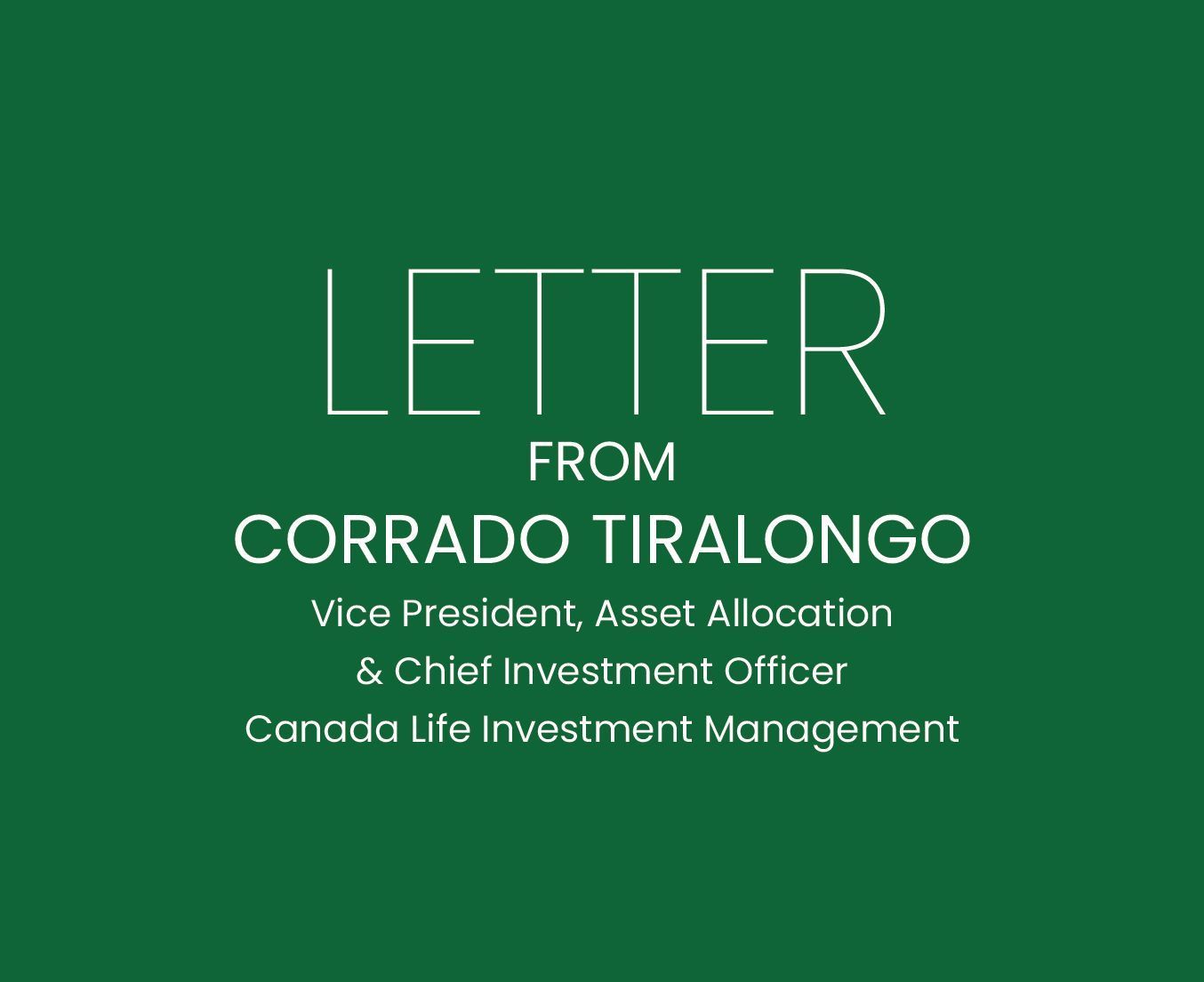The third quarter of 2025 reinforced a central tension in today’s markets: resilience in the United States in contrast to weakness elsewhere.
While U.S. growth continues to surprise on the upside, Canada, Europe, and the UK remain close to stagnation. At the same time, central banks have begun to ease cautiously, inflation pressures are proving uneven and valuations in equity markets are increasingly demanding. For investors, this is a period in which staying diversified and resilient is more important than attempting to predict each short-term twist.
Global economy: resilience meets fragility
The U.S. economy has delivered another quarter of robust performance. GDP growth is tracking close to 3% annualized[1], supported by strong consumption and business investment. Productivity growth is particularly striking, estimated at 1.7%[2] and higher by alternative measures, as artificial intelligence (AI) investment begins to show tangible benefits. This productivity strength is helping offset weaker payroll growth and revisions that reduced last year’s job gains.
Canada’s picture is less encouraging. The economy contracted in the second quarter and is barely positive in the third. Rising unemployment, combined with trade headwinds, leaves Canada close to recessionary territory. Europe and the UK face similar challenges, growing at only a fraction of the U.S. pace. These divergences highlight the unusual character of the current cycle: while the U.S. powers ahead, its peers struggle to regain momentum. For investors, the implication is that opportunity remains concentrated, but global fragility can’t be ignored.
Central banks: easing with caution
Policy has shifted from restraint to cautious easing. The Federal Reserve delivered a September rate cut, with Chair Powell emphasising “risk management” rather than any immediate deterioration in economic conditions. With core personal consumptions expenditure (PCE) inflation still running at 2.9%[3] and unemployment edging only gradually higher, the Fed has scope for modest easing, not an aggressive cycle. We expect about 75 basis points of cuts spread into 2026, fewer than the market currently prices.
The Bank of Canada also cut rates by 25 basis points, a move that was anticipated, given soft domestic data. Although markets are pricing in additional rate cuts, our base case is that the Bank of Canada is to deliver two cuts in this cycle, with the possibility of more only if unemployment rises faster than expected. Meanwhile, the European Central Bank and the Bank of England have opted to hold rates steady, constrained by persistent services inflation. Across economies, the tone is consistent: central banks are easing as insurance or normalization, not as emergency rescue. For markets, that distinction is crucial. Across economies, the tone is consistent: central banks are easing as insurance or normalization, not as emergency rescue. For markets, that distinction is crucial.
Inflation: muted goods, sticky services
A key concern in 2025 has been the effect of tariffs on consumer prices. So far, pass-through has been modest. Core goods inflation remains contained, while the larger services component is proving sticky. In the U.S., core inflation remains close to 3%[4], suggesting only a gradual path back towards the target. In Canada and Europe, softer growth has moderated inflation pressures, but policymakers remain alert to risks of persistence in wages and services costs.
This uneven mix of muted goods inflation and stickier services reinforces the cautious stance from central banks. Inflation is not derailing growth, but neither is it fully vanquished.
Equities: optimism alongside red flags
Equity markets continue to reflect this balance between resilience and risk. In the U.S., earnings growth and AI-related investment have supported upgrades to the outlook. We now forecast the S&P 500 to reach 6,750 by the end of 2025 and 7,250 in 2026. Forward earnings per share are expected to rise to $290 in 2025 and $300 in 2026, leaving valuations at forward multiples of 23 to 24. These are below the dot-com peak of 25 but well above long-run averages near 17.
At the same time, warning signs are accumulating. Market concentration remains extreme, with the top ten firms accounting for nearly 40% of index weight. Investor sentiment surveys are approaching thresholds that in past cycles preceded bubble conditions. U.S. defined contribution pension plans and households now hold a record share of their assets in equities, the highest in at least 75 years[5]. Historically, such peaks have often been followed by weaker long-term returns, even if markets continue to rise in the short run.
Outside the U.S., the picture is more muted. Canadian equities have outpaced the S&P 500 this year, helped by strength in financials and materials, but the domestic economic outlook is weak. Emerging markets remain constrained by tariff headwinds and fragile financial conditions. The net result is that equity optimism rests disproportionately on the U.S., raising the importance of diversification.
Commodities: gold shines, oil softens
Commodities tell a story of divergence. Gold has surged above $3,500 per ounce, supported by expectations of U.S. rate cuts, fiscal concerns and strong central bank demand. Global official gold reserves are now close in value to U.S. Treasury holdings, underscoring gold’s re-emergence as a core reserve asset. The drivers of central bank demand suggest that gold strength will remain a structural theme.
Oil faces the opposite backdrop. OPEC+ has prioritised market share, raising supply even as demand softens. We expect prices to fall toward $60 in 2025 and $50 in 2026. The contrast between gold and oil reflects both economic fundamentals and shifting investor behaviour.
Fiscal backdrop: political constraints
Government deficits remain elevated, particularly in the U.S., where the shortfall is projected at 6% of GDP[6], despite $30 billion per month in tariff revenue[7]. Europe faces its own challenges, with political instability in France already disrupting fiscal repair efforts. The constraint is less economic than political. Markets remain willing to fund deficits, but the absence of credible consolidation plans adds to long-term risk.
Portfolio positioning: resilience over precision
For investors, the challenge is to participate in U.S. resilience while managing the risks of stretched valuations, high concentration and uneven global conditions.
Our approach emphasises resilience over precision. Core U.S. equity exposure remains important, but we balance this with global diversification and multi-factor strategies that reduce dependence on narrow leadership. Within fixed income, we view alternatives such as private credit and mortgages as valuable sources of income and duration management, particularly in a higher-for-longer environment. Liquidity and flexibility remain central, allowing portfolios to absorb sudden shocks if risks around AI investment, funding markets or fiscal policy materialize.
Above all, the lesson of this quarter is that risks often build quietly and break suddenly. By maintaining balanced exposures, holding adequate liquidity and preparing for a wider distribution of outcomes, portfolios can remain positioned for opportunity while protecting against fragility.
Sincerely,

Corrado Tiralongo
Vice President, Asset Allocation & Chief Investment Officer
Canada Life Investment Management
[1] Bureau of Economic Analysis - U.S. GDP releases
[2] Bureau of Labor Statistics (BLS) – Productivity and Costs reports
[3] FRED - Core PCE Price Index
[4] FRED - Core PCE Price Index
[5] Federal Reserve Flow of Funds - Financial Accounts of the U.S. (Z.1) & Investment Company Institute - Retirement market statistics
[6] Congressional Budget Office (CBO) - Monthly Budget Review: August 2025
[7] U.S. Treasury –Monthly Treasury Statement
The views expressed in this commentary are those of Canada Life Investment Management Ltd. as at the date of publication and are subject to change without notice. This commentary is presented only as a general source of information and is not intended as a solicitation to buy or sell specific investments, nor is it intended to provide tax or legal advice. Prospective investors should review the offering documents relating to any investment carefully before making an investment decision and should ask their financial security advisor for advice based on their specific circumstances.
This material may contain forward-looking information that reflects our or third-party current expectations or forecasts of future events. Forward-looking information is inherently subject to, among other things, risks, uncertainties and assumptions that could cause actual results to differ materially from those expressed herein. These risks, uncertainties and assumptions include, without limitation, general economic, political and market factors, interest and foreign exchange rates, the volatility of equity and capital markets, business competition, technological change, changes in government regulations, changes in tax laws, unexpected judicial or regulatory proceedings and catastrophic events. Please consider these and other factors carefully and not place undue reliance on forward-looking information. The forward-looking information contained herein is current only as of Oct. 6, 2025. There should be no expectation that such information will in all circumstances be updated, supplemented or revised whether as a result of new information, changing circumstances, future events or otherwise.
Canada Life and design and Canada Life Investment Management and design are trademarks of The Canada Life Assurance Company. Counsel mutual funds are managed by Canada Life Investment Management Ltd., a wholly owned indirect subsidiary of The Canada Life Assurance Company (“Canada Life”). Canada Life is a wholly owned subsidiary of Great West-Lifeco Inc. (TSX: GWO) and a member of the Power Corporation Group of companies. Investment Planning Counsel Inc. is a fully integrated wealth management company.
Trademarks owned by Investment Planning Counsel Inc. and licensed to its subsidiary corporations.





